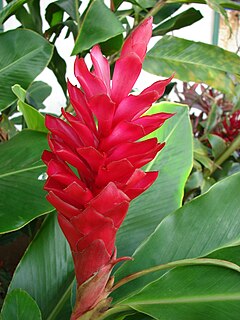
The Zingiberales are flowering plants forming one of four orders in the commelinids clade of monocots, together with its sister order, Commelinales. The order includes 68 genera and 2,600 species. Zingiberales are a unique though morphologically diverse order that has been widely recognised as such over a long period of time. Usually large herbaceous plants with rhizomatous root systems and lacking an aerial stem except when flowering. Flowers are usually large and showy, and the stamens are often modified (staminodes) to also form colourful petal-like structures that attract pollinators.
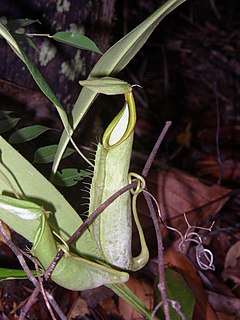
Nepenthes hirsuta, the hairy pitcher-plant, is a tropical pitcher plant endemic to Borneo. It is characterised by an indumentum of thick brown hairs, which is even present on the inflorescence. Pitchers are mostly green throughout with some having red blotches on the inside surfaces.
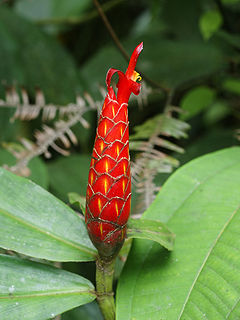
Costus is a group of perennial herbaceous plants in the family (Costaceae) described by Linnaeus as a genus in 1753. It was formerly known as Hellenia after the Finnish botanist Carl Niclas von Hellens. It is widespread through tropical and subtropical regions of Asia, Africa, and the Americas.

Nepenthes glandulifera is a species of pitcher plant endemic to the Hose Mountains of central Sarawak. This plant is so named for the black speckles around the petioles. The species's discoverer, Ch'ien Lee, initially thought they were a sign of disease. After further investigation, it was realised that the black speckles were actually nectar glands. The species is also notable for having a very prominent indumentum. It appears to be closely related to N. pilosa. Nepenthes glandulifera is not known to form natural hybrids with any other species.
Paulus Johannes Maria "Paul" Maas is a botanist from the Netherlands and a specialist in the flora of the neotropics. Maas has identified and named about two hundred fifty plants from the Burmanniaceae, the Costus Family (Costaceae), the Gentian Family (Gentianaceae), the Bloodwort Family (Haemodoraceae), the Banana Family (Musaceae), the Olacaceae, the Triuridaceae, and the Ginger Family (Zingiberaceae).
Hillegonda (Hiltje) Maas-van de Kamer is a botanist at the Institute of Systematic Botany at Utrecht University. She is the wife of Professor Paul Maas and together they have published many papers. She is a specialist in the flora of the neotropics.

Costus osae is a rare member of the Costus family. One of many rare tropical plants in the Costus family, Costus osae is a species native to Costa Rica described in 1997 . It has also been reported from Colombia.

Chamaecostus cuspidatus, common name fiery costus or spiral flag, is a species of herbaceous plant in the Costaceae family native to eastern Brazil. In the Philippines, it is known as insulin plant because of its use in Ayurvedic medicine for its purported anti-diabetic properties.
Chamaecostus is a group of plants in the Costaceae described as a genus in 2006. It is endemic to South America.
- Chamaecostus congestiflorus - Venezuela, N Brazil, Guyana, Suriname, French Guiana
- Chamaecostus curcumoides - French Guiana
- Chamaecostus cuspidatus - E Brazil
- Chamaecostus fragilis - Colombia, N Brazil
- Chamaecostus fusiformis - Pará
- Chamaecostus lanceolatus - Colombia, Venezuela, Brazil, Guyana, Suriname, French Guiana
- Chamaecostus subsessilis - Brazil, Bolivia

Dimerocostus is a group of plants in the Costaceae described as a genus in 1891. It is native to Central and South America.
- Dimerocostus argenteus(Ruiz & Pav.) Maas - Peru, Bolivia
- Dimerocostus cryptocalyxN.R.Salinas & Betancur - Colombia
- Dimerocostus strobilaceusKuntze - Honduras, Nicaragua, Costa Rica, Panama, Colombia, Venezuela, Guyana, Suriname, Ecuador, Peru, Bolivia
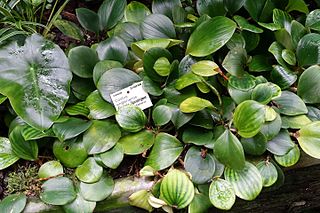
Paracostus is a group of plants in the Costaceae described as a genus in 2006. It is native to Borneo and to tropical Africa.
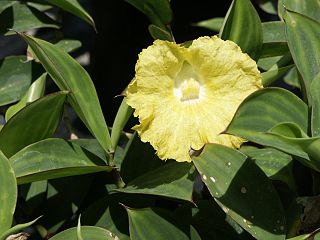
Monocostus is a group of plants in the Costaceae described as a genus in 1904. There is only one known species, Monocostus uniflorus, endemic to Peru.
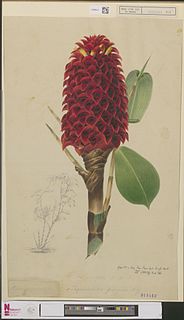
Tapeinochilos is a group of plants in the Costaceae described as a genus in 1869. It is native to Queensland, Papuasia, and the Indonesian Province of Maluku.

Hellenia is a genus of plants in the Costaceae described as a genus with this name in 1791. It is native to Southeast Asia, southern China, the Indian Subcontinent, New Guinea, and Queensland.
- Hellenia globosa(Blume) S.R.Dutta - Thailand, Peninsular Malaysia, Borneo, Sumatra, Java
- Hellenia speciosa(J.Koenig) S.R.Dutta - China, Indian Subcontinent, Andaman & Nicobar, Indochina, Malaysia, Indonesia, Philippines, New Guinea, Bismarck Archipelago, Queensland; naturalized in Mauritius, Réunion, Hawaii, Central America, West Indies
Idioglossa metallochrysa is a species of moth of the family Batrachedridae. It is known from Australia.

Costus curvibracteatus is a tropical rhizomatous perennial native to Costa Rica and Panama. A member of the spiral ginger family of plants, its common name is orange tulip ginger. It is also sometimes referred to as spiral ginger; however, this common name is better associated with Costus barbatus, a more widely cultivated and very similar species. Despite the name and its relation to the ginger family (Zingiberaceae), the rhizomes of the orange tulip ginger are not edible.
The ginger-families or ginger group or Core Zingiberales is a terminal clade in the order Zingiberales (:Monocotyledoneae) that comprises Zingiberaceae, Costaceae, Marantaceae and Cannaceae. Their shared synapomorphy of a single fertile anther and four or five highly modified staminodia differentiate them from the basal paraphyletic assemblage of the "banana-families".

Costus malortieanus is a specie of perennial herbaceous plants in the family Costaceae. It is found in Costa Rica, Nicaragua and Honduras.















